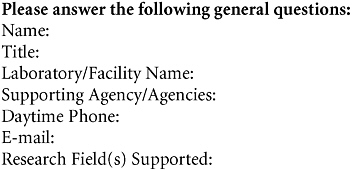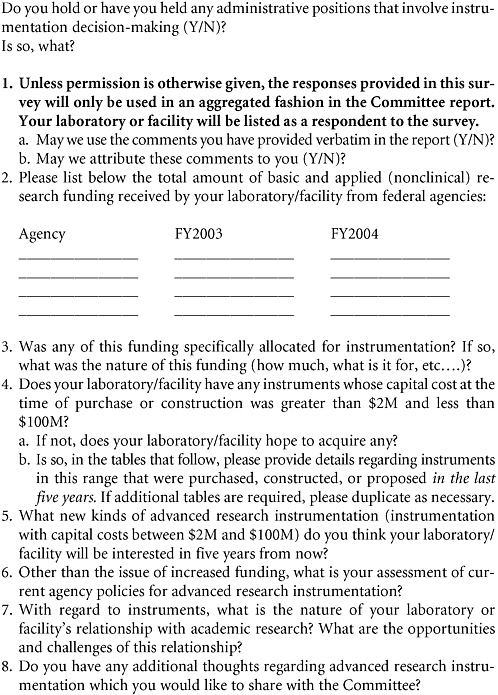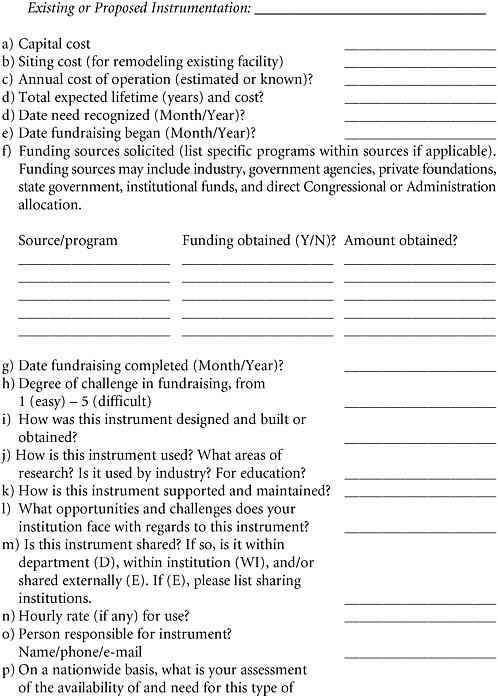F
Summary of National Laboratory Survey Results
CONTENTS
SUMMARY
In total, 10 federal laboratories or research centers responded to the committee’s survey on instrumentation. Four reported instrumentation with capital costs between $2 million and $100 million. The list of respondents is included at the end of this appendix.
In the survey, the committee asked about the relationship between the laboratory and universities. Some laboratories offer use of their instruments free of charge to external users as long as the results are openly published. Some ARIF at federal intramural research centers are open for use, with fees charged for external use; others are not shared. Excerpts from some comments related to the laboratory-university relationship are excerpted later.
Oak Ridge National Laboratory (ORNL) provided an extensive response to the committee’s survey with detailed information on six ARIF at the laboratory at large and 13 ARIF at the Spallation Neutron Source that were constructed or acquired in the preceding five years. A summary of ORNL’s response is included in this appendix to provide a picture of ARIF at a national laboratory.
Like the universities, many of the respondents noted difficulty in finding sufficient support for operations, maintenance, and staff. The annual cost of operation for the ARIF reported ranged from $100,000 to several million dollars.
Several laboratories specifically commented on the importance of instrumentation, and ARIF in particular. With regard to the definition of ARIF, the Princeton Plasma Physics Laboratory noted that “research instrumentation should be broadened to include capacity computing. Simulation is becoming a third leg of the scientific enterprise along with theory and experiment.”
RELATIONSHIP WITH UNIVERSITIES
A number of national laboratories described close relationship with university researchers, and several noted the importance of staff.
The very nature of high-energy physics research requires close collaboration between the laboratory and our university partners. The effort involved in the design, construction, test, and commissioning of most of our detector systems (instruments) is shared among the participating universities and the laboratory. Most of our collaborations are now international in nature. Creating well-defined, clear and concise responsibilities (effort and funding) with participating institutions is always a challenge.
Fermi National Accelerator Laboratory
Close relationship with academic community to ensure that proposed instruments meet scientific needs. In some cases, academia had direct input into concepts.
Anonymous
Intramural research laboratory
We carry out mainly academic research. We educate over 500 scientists a year in analytical techniques. This is a challenging task that put a lot of stress on the staff. These are excellent experts who give away their knowledge generously. Yet, this kind of scientists is often not appreciated enough.
Ivan Petrov
Principal Research Scientist, Adjunct Prof
Center for Microanalysis of Materials
The Frederick Seitz Materials Research Laboratory
One intramural research laboratory expressed difficulty in sharing advanced instrumentation with outside users:
… it is difficult to balance our need to meet … core mission responsibilities with our desire to share access to advanced instrumentation with academia. Our … facilities rely on well-trained users, and so allowing use by temporary academic researchers and other outside users with unknown levels of training and experience is an important issue that we need to resolve before opening [them] to broader outside use.
OTHER COMMENTS
Instrumentation Needs
“We need extensive small- ($10K) to medium-scale ($100K) research collaborations addressing all aspects of living marine resource biology, ecology, and utilization. Our challenges are mainly geographic and cost of operations in Alaska and the Arctic oceans. No instrumentation with capital cost greater than $2 million is likely to be needed in the future.”
Alaska Fisheries Science Center
Supporting Agency/Agencies: NOAA, National Marine Fisheries Service
“DOE/BES dedicated $1.1 million in FY 2004 to our program for equipment purchases. We are attempting to locate funding for an aberration-corrected STEM/ TEM with a monochromator and in-colunm energy filter (capital cost $3 million) and a UHV aberration-corrected instrument with large space in the sample area for atomic resolution dynamic electron microscopy observations (capital cost $4.5-$5 million). Finding funding for these instrument is difficult.
We believe we are in a unique position to design and operate an atomic resolution TEM with for in situ science as an open facility. Three workshops in recent years have clearly demonstrated the scientific community needs such an instrument. DOE may sponsor such an instrument within a program on aberration-corrected microscopy in the time frame 2010-12. Yet the demand right now is great and the impact would be enormous. The cost is ~$5M and has proven an insurmountable barrier for now.
We participated in the first NSF program for Instrumentation for Materials Research—Major Instrumentation Projects for over $2M with, in my view, an excellent proposal. It was rejected rather hurriedly based on the whimsical comments from one of the reviewers.
In terms of future instrumentation needs, we think we would need a UHV aberration-corrected TEM dedicated to in situ science.”
Ivan Petrov
Principal Research Scientist, Adjunct Prof
Center for Microanalysis of Materials
The Frederick Seitz Materials Research Laboratory
“Fermilab has the FNPL—Fermilab NICADD PhotoInjector Laboratory (capital cost $7 million), Fermilab Magnet Test Facility (capital cost to replace today would be $10 million), KTeV Detector (capital cost $30 million), and the MIPP Experiment FNAL-E907 (capital cost $4 million). It is currently attempting to get funding for the Superconducting Module and Test Facility (SMTF) (capital cost $97 million).
Fermilab has interest in acquiring new research instrumentation for our both our physics and accelerator R&D programs. A number of new experiment proposals are under development that would potentially fall with the $2M to $100M cost window. The laboratory is also involved in a number of R&D areas addressing the needs of future accelerators that will require instrumentation costing in access of $2M.”
Fermi National Accelerator Laboratory
Policy Issues
“Creating collaborations between various agencies and even various divisions within a single agency can be difficult, frustrating, and results in increased project costs that could be avoided if better mechanisms were in place to deal with multiagency spanning projects. An example would be working across interdivisional boundaries with a single agency, such as DOE/HEP and DOE/NS on a project that could exist in both divisions. A simple method of conducting business in this case could and would result in reduced project costs and reduced project time to completion. “
Fermi National Accelerator Laboratory
“Over the past several years the research infrastructure of NIH was improved significantly. Besides careful planning this required substantial financial resources. The challenge will be to maintain and further improve the technological base without much increase of the NIH budget.
Very often advanced research instruments have specific requirements regarding their operational environment. The multilayered structure of Federal Agencies, with shared responsibility for building design, construction, and maintenance, makes it cumbersome to ensure that those requirements are met and may add needlessly to the cost of construction and maintenance.”
Klaus Gawrisch
Senior Investigator
Lab: Laboratory of Membrane Biochemistry & Biophysics (LMBB),
National Institute on Alcohol Abuse and Alcoholism (NIAAA),
National Institutes of Health (NIH)
Supporting Agency: Defense Advanced Research Project Agency (DARPA)
“Federal and Agency-level Policy on acquisition/development of Advanced Computational Instrumentation … is dynamic and can drive short-term changes in instrumentation acquisition direction.”
Anonymous
“While competition is good for surfacing new, original ideas and research concepts, more directed funding is appropriate for maturing the technologies. Instruments such as lasers and lidars should be considered as national facilities. Directed funding for continuous improvement is needed, but difficult to secure.”
Anonymous
“A small budget exists within the office of fusion energy sciences to develop novel diagnostics. this is an important effort and should be broadened to include the development of diagnostics for a buring plasma experiment.”
Princeton Plasma Physics Laboratory
“Current agency policies for advanced research instrumentation are open and positive.”
Southwest Fisheries Science Center
NOAA
General Thoughts
“Most ‘advanced’ instrumentation for high-quality and rigorous research is customized for the particular investigator/investigation and requires specialists’ skill in the acquisition and interpretation of raw data, conversion to engineering units, and interpretation of results. The customization can be in detectors and sensors, specimen preparation, specimen environment, or data acquisition and control algorithms and software. The ability of the end user to interpret the results meaningfully is a key part of the ‘instrumentation’ and may not be readily transferable to other researchers. When the instrumentation’s basic principles are well understood and the apparatus is made reliable and usable in the general laboratory, it will find a general audience of research users (in its field). At that point it will migrate to the “mainstream” to be provided by instrumentation equipment vendors and become less ‘investigator unique.’”
Anonymous
“Research instrumentation should be broadened to include capacity computing. Simulation is becoming a third leg of the scientific enterprise along with theory and experiment. In addition to the very large supercomputers, smaller capacity computing centers are required to develop codes and run problems, which require fewer processors.”
Princeton Plasma Physics Laboratory
CASE STUDY—OAK RIDGE NATIONAL LABORATORY
The ORNL performs research in neutron science, energy, high-performance computing, complex biologic systems, advanced materials, and national security. Most of the support for the laboratory comes from the Department of Energy, although it receives 20% of its support from other agencies. About 3% of the laboratory’s FY 2004 funding was allocated for work associated with instrumentation. This internally allocated funding went to continuing costs, including operation and maintenance, and instrument development and modification. Most of the instrumentation at ORNL is shared with academic researchers through formal user programs and collaborative projects.
The laboratory reported a total of 19 ARIF that were constructed or acquired in the preceding 5 years. Thirteen are at the Spallation Neutron Source (SNS), including a number of spectrometers, diffractometers, and beamlines, all for use of neutron radiation. The design and engineering of those instruments are carried
out either at SNS or in close collaboration with industry vendors or academic institutions or consortia. SNS instruments are general available to researchers from national laboratories, universities, and industry through a peer-reviewed proposal system.
ORNL also reported six other ARIF, primarily advanced microscopes. An aberration-corrected transmission electron microscope ($3.2 million in combined acquisition and upgrade costs) was reported; it required $5 million for construction of a new building to house it and $100,000 per year in operation costs. An instrument of that sort is used by a broad array of disciplines, including basic condensed matter, engineering, physics, chemical, biology, and environmental science.
NATIONAL LABORATORY SURVEY ON ADVANCED RESEARCH INSTRUMENTATION
Today, instrumentation plays a critical role in scientific and engineering research and exploration. We would like to get your help in gaining a better understanding of the issues related to instrumentation in your laboratory and your thoughts on federal policies. This survey is part of a study being conducted by the National Academies Committee on Advanced Research Instrumentation in response to Section 13(b) of the NSF Authorization Act of 2002. The Instrumentation Committee is under the aegis of the Committee on Science, Engineering, and Public Policy (COSEPUP). COSEPUP, chaired by Dr. Maxine Singer, is the only joint committee of the three honorific academies: the National Academy of Sciences, the National Academy of Engineering, and the Institute of Medicine. Its overall charge is to address cross-cutting issues in science and technology policy that affect the health of the national research enterprise.
The study is examining federal programs and policies related to advanced research instrumentation used for interdisciplinary, multidisciplinary, and disciplinary research. If needed, the Committee will propose policies to make the most effective use of federal agency resources to fund such instruments. Advanced research instrumentation, for the purposes of this survey, is defined as instrumentation that is not categorized by NSF as Major Research Instrumentation ($100,000 to $2 million in capital cost) or as Major Research Equipment (more than several tens of millions of dollars), but instead falls in between these two designations.
To respond to its charge from Congress and NSF, the Committee is interested in hearing your thoughts on instrumentation at your laboratory as well as your opinions concerning current and possible future federal programs and policies for advanced research instrumentation.
We hope you will be willing to participate in this important information-gathering effort. We recognize that answering all the questions in this survey may be challenging. We only ask that you do the best you can in providing the information requested. If another person at your laboratory is better suited to answer this survey, please forward it to them, but please let us know to whom you sent it. We also encourage you to send this survey to anyone, particularly laboratory or facility directors, who you believe may have additional thoughts. Their comments may be sent either to you for compilation or directly to instrumentation@nas.edu.
We would appreciate receiving your response by Monday, April 11, 2005. Please return the completed survey via e-mail as an attachment to instrumentation@nas.edu or by fax to 202-334-1667. If you have any questions, please contact the study director, Dr. Deborah Stine, at dstine@nas.edu or 202-334-3239.
Thank you for your time and participation. For more information on the study, please visit our website at http://www7.nationalacademies.org/instrumentation/.
National Academies Committee on Advanced Research Instrumentation
MARTHA KREBS (Chair), President, Science Strategies
DAVID BISHOP, VP Nanotechnology Research, President, NJNC, Bell Labs
MARVIN CASSMAN, Independent Consultant
ULRICH DAHMAN, Director, National Center for Electron Microscopy, Lawrence Berkeley National Laboratory
THOM H. DUNNING, Jr., Director, National Center for Supercomputing Applications, University of Illinois, Urbana-Champaign
FRANK FERNANDEZ, Distinguished Instititute Technical Advisor, Stevens Institute of Technology
MARILYN L. FOGEL, Staff Member, Geophysical Laboratory, Carnegie Institution of Washington
LESLIE KOLODZIEJSKI, Professor, Electrical Engineering and Computer Science, Massachusetts Institute of Technology
ALVIN KWIRAM, Professor of Chemistry, University of Washington, Vice Provost for Research Emeritus
WARREN S. WARREN, Professor of Chemistry, Director, NJ Center for Ultrafast Laser Applications, Princeton University
DANIEL WEILL, Professor (by courtesy), University of Oregon, Department of Geological Sciences
National Academies Committee on Advanced Research Instrumentation National Laboratory Survey of Instrumentation Funding and Support


LIST OF RESPONDENTS
Ames Research Center, National Aeronautics and Space Administration
Center for Microanalysis of Materials, Frederick Seitz Materials Research Laboratory
Electronics and Electrical Engineering Laboratory, National Institute of Standards and Technology
Fermi National Accelerator Laboratory
Laboratory of Membrane Biochemistry and Biophysics, National Institute on Alcohol and Alcoholism, National Institutes of Health
National Marine Fisheries Service, National Oceanic and Atmospheric Administration
Oak Ridge National Laboratory
Princeton Plasma Physics Laboratory
Science Directorate, National Aeronautics and Space Administration
Southwest Fisheries Science Center, National Oceanic and Atmospheric Administration














